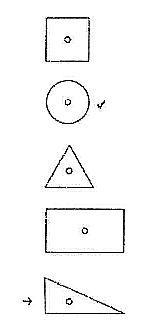Kolmogorov Student Olympiad in Probability
There are too many Olympiads. Now there is even a special undergraduate Olympiad in probability, called Kolmogorov Student Olympiad in Probability. It is run by the Department of Probability Theory of Moscow State University. I just discovered this tiny Olympiad, though it has been around for 13 years.
A small portion of the problems are accessible for high school students. These are the problems that I liked. I edited them slightly for clarity.
Second Olympiad. Eight boys and seven girls went to movies and sat in the same row of 15 seats. Assuming that all the 15! permutations of their seating arrangements are equally probable, compute the expected number of pairs of neighbors of different genders. (For example, the seating BBBBBBBGBGGGGGG has three pairs.)
Third Olympiad. One hundred passengers bought assigned tickets for a 100-passenger railroad car. The first 99 passengers to enter the car get seated randomly so that all the 100! possible permutations of their seating arrangements are equally probable. However, the last passenger decides to take his reserved seat. So he arrives at his seat and if it is taken he asks the passenger in his seat to move elsewhere. That passenger does the same thing: she arrives at her own seat and if it is taken, she asks the person to move, and so on. Find the expected number of moved passengers.
Third Olympiad. There are two 6-sided dice with numbers 1 through 6 on their faces. Is it possible to “load” the dice so that when the two dice are thrown the sum of the numbers on the dice are distributed uniformly on the set {2,…,12}? By loading the dice we mean assigning probabilities to each side of the dice. You do not have to “load” both dice the same way.
Sixth Olympiad. There are M green and N red apples in a basket. We take apples out randomly one by one until all the apples left in the basket are red. What is the probability that at the moment we stop the basket is empty?
Seventh Olympiad. Prove that there exists a square matrix A of order 11 such that all its elements are equal to 1 or −1, and det A > 4000.
Twelfth Olympiad. In a segment [0,1] n points are chosen randomly. For every point one of the two directions (left or right) is chosen randomly and independently. At the same moment in time all n points start moving in the chosen direction with speed 1. The collisions of all points are elastic. That means, after two points bump into each other, they start moving in the opposite directions with the same speed of 1. When a point reaches an end of the segment it sticks to it and stops moving. Find the expected time when the last point sticks to the end of the segment.
Thirteenth Olympiad. Students who are trying to solve a problem are seated on one side of an infinite table. The probability that a student can solve the problem independently is 1/2. In addition, each student will be able to peek into the work of his or her right and left neighbor with a probability of 1/4 for each. All these events are independent. Assume that if student X gets a solution by solving or copying, then the students who had been able to peek into the work of student X will also get the solution. Find the probability that student Vasya gets the solution.
Share: